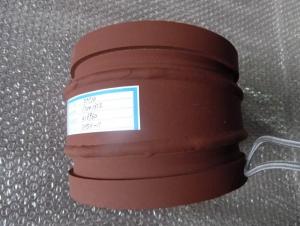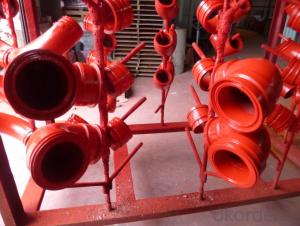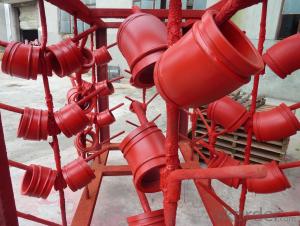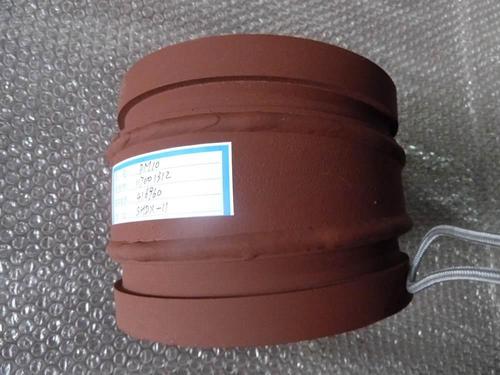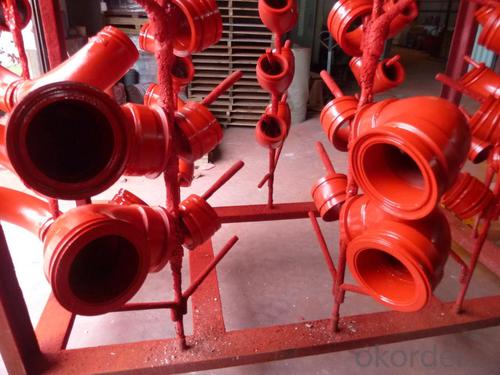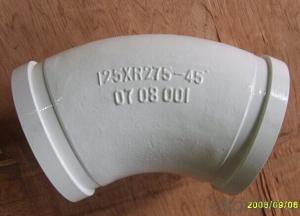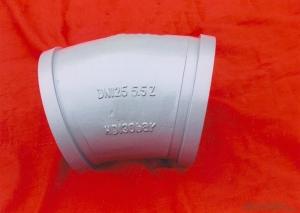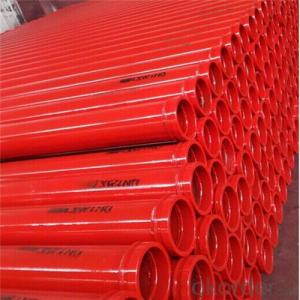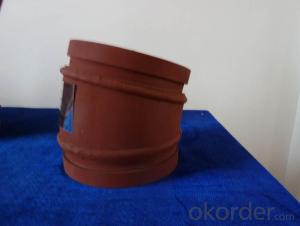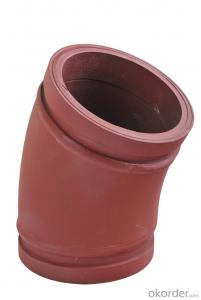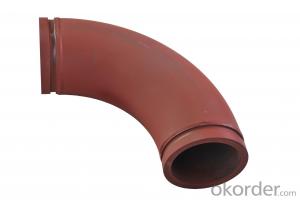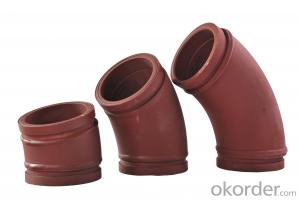Twin Wall Elbow for Concrete Pump R275 10DGR
- Loading Port:
- Tianjin
- Payment Terms:
- TT or LC
- Min Order Qty:
- 20 pc
- Supply Capability:
- 5000 pc/month
OKorder Service Pledge
OKorder Financial Service
You Might Also Like
Product Description:
Product Name: Twin Wall Elbow (Twin Wall Flange)
1. Specification
(1) Material: Q235 (outside) + GCr15(inside)
(2) Thickness: 3mm (outside) + 9mm (inside)
(3) Technology: Quenching under high temperature
(4) Characteristics: the inner rigidity to 63 HRC; the outside has so high toughness to keep the inner.
(5) Matched with: Twin wall flange, Alloy (GCr15) + 20#
(6) Working Pressure:170bar
(7) Service life: above 60,000 cubic meters.
(8) Package: PP woven bag and plastic cap
2. Application
Concrete mixing and delivery.
3. Package
Put into containers.
FAQ:
Q1: Why buy Materials & Equipment from OKorder.com?
A1: All products have its ISO certifications, adheres to the highest standards and a commitment to supply chain safety and customer satisfaction.
Q2: How do we guarantee the quality of our products?
A2: We have established an advanced quality management system which conducts strict quality tests at every step, from raw materials to the final product. At the same time, we provide extensive follow-up service assurances as required.
Q3: How soon can we receive the product after purchase?
A3: Within three days of placing an order, we will begin production. The specific shipping date is dependent upon international and government factors, but is typically 10 to 30 workdays.
Q4: If we can produce Twin Wall Elbow (Twin Wall Flange) according to customers request?
A4: Yes, we can produce Twin Wall Elbow (Twin Wall Flange) according to the difference country situations to make it suitable to the market and customers. We have very professional technical team to make the design.
Q5: How to make a quick resolution for after service?
A5: We have overseas branches all-around of world, If needed, the seller shall dispatch 2 engineers to the buyer's site for supervision of training. The buyer shall make available of necessary facilities &skilled personnel at site for training.
Images:
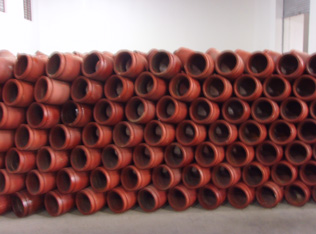
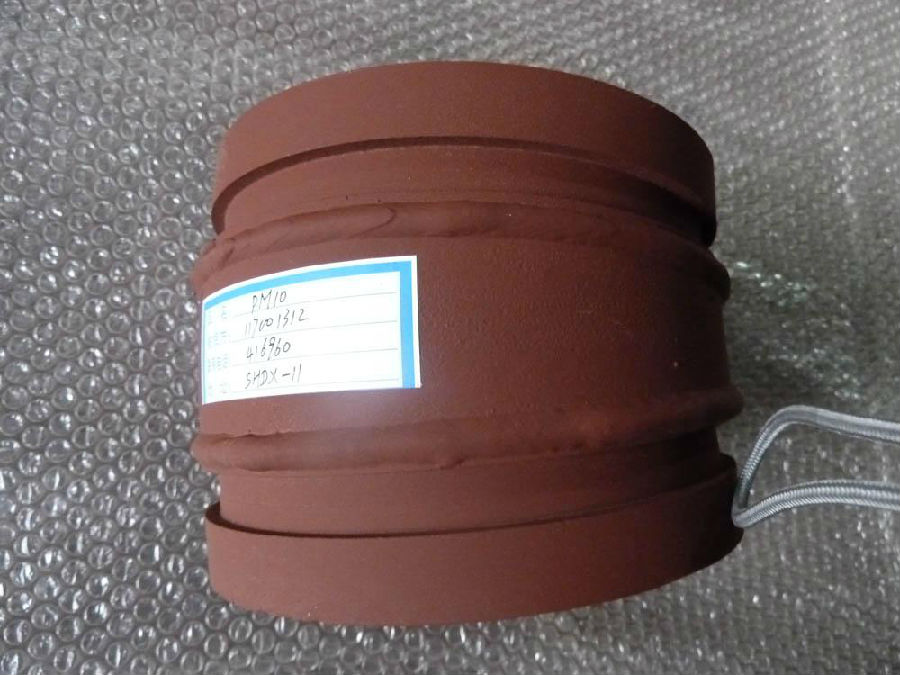
- Q: Are there any specific guidelines for the installation of hydraulic filters or strainers in concrete pump spare parts?
- Specific guidelines exist for the installation of hydraulic filters or strainers in concrete pump spare parts. These guidelines should be followed to ensure proper installation and functionality of the filter or strainer. Here are some important considerations: 1. Size and Compatibility: It is crucial to choose a hydraulic filter or strainer that is the correct size and compatible with the specific make and model of the concrete pump. Failure to do so can lead to inadequate filtration or damage to the hydraulic system. 2. Location: The filter or strainer should be installed in a location that allows for easy access and maintenance. It should be positioned in a way that facilitates proper filtration without obstructing the flow of hydraulic fluid. 3. Mounting: To prevent movement or vibration during operation, the filter or strainer must be securely mounted. It is essential to adhere to the manufacturer's instructions regarding proper mounting techniques and torque specifications. 4. Orientation: Pay attention to the recommended orientation of the filter or strainer. Some filters have specific flow direction requirements, and incorrect installation can impact their performance and efficiency. 5. Protection: Consider adding extra protection, such as a guard or shield, to shield the filter or strainer from external factors like debris or impacts. This can extend the lifespan and effectiveness of the filter. 6. Maintenance: Regularly inspecting and cleaning the filter or strainer is important to ensure optimal functioning. Adhere to the manufacturer's recommended maintenance schedule and procedures for replacement or cleaning to maintain efficient filtration. Remember to consult the manufacturer's instructions and guidelines for the specific hydraulic filter or strainer being installed, as they may have unique recommendations or requirements for their product.
- Q: Which is the best home made concrete pump car?
- The first line is 31 and Zhonglian, the price is expensive, the car is big, the problem is not, and there are many small problems
- Q: How can I minimize downtime during the replacement of concrete pump spare parts?
- To minimize downtime during the replacement of concrete pump spare parts, it is crucial to follow a few key steps. First, ensure that you have a comprehensive understanding of the specific spare parts required for your concrete pump. This will help you streamline the ordering process and minimize delays. Additionally, it is essential to schedule regular maintenance and inspections to identify any potential issues beforehand, allowing you to proactively replace parts before they fail. Lastly, work with a reputable supplier who can provide high-quality spare parts promptly, reducing downtime.
- Q: What are the different sizes of concrete pump pipes available?
- Concrete pump pipe sizes vary based on the unique requirements and specifications of each construction project. Typically, these pipes range in diameter from 2 inches to 6 inches. The most commonly utilized sizes are 2 inches, 3 inches, 4 inches, and 5 inches. The selection of the pipe size depends on several factors, including the concrete's volume and pressure, the distance it needs to travel, and the equipment type. Smaller pipes with a smaller diameter are suitable for shorter distances and lower concrete volumes, while larger pipes are used for longer distances and higher volumes. Choosing the appropriate pipe size is crucial to ensure efficient and safe concrete pumping. By using the correct pipe size, pressure loss is minimized, and a consistent flow rate is maintained. Moreover, it helps prevent blockages or clogs in the system. To determine the most suitable pipe size for a specific construction project, it is advisable to consult with a concrete pumping professional or engineer.
- Q: How can a faulty pressure gauge affect the concrete pumping process?
- A faulty pressure gauge can significantly impact the concrete pumping process in several ways. Firstly, it may provide inaccurate readings, leading to an incorrect assessment of the pressure within the system. This can result in either excessively high or low pressure being applied during the pumping process, which can lead to various issues. If the faulty pressure gauge displays a higher pressure than the actual value, it may cause over-pressurization of the concrete pump. This can lead to potential damage to the equipment, such as burst hoses or pipes, which can be dangerous for workers nearby. Additionally, excessive pressure can cause the concrete to be pumped too forcefully, potentially leading to the material splattering or leaking from the delivery system, resulting in wastage and an uneven distribution of the concrete. On the other hand, an incorrectly low pressure reading from the faulty gauge can have its own set of problems. Insufficient pressure within the pumping system can result in the concrete not being adequately delivered to the desired location. This can cause delays in the construction process and result in uneven or incomplete concrete placement, affecting the integrity and strength of the structure being built. Moreover, a faulty pressure gauge may also contribute to inaccurate monitoring of the concrete's slump or consistency. The pressure gauge is often used as an indicator of the concrete's flowability, and if the gauge is faulty, it may provide misleading information about the material's workability. This can result in the concrete mix being either too fluid or too stiff, leading to difficulties in pumping and potentially compromising the quality of the finished concrete structure. In conclusion, a faulty pressure gauge can have severe consequences on the concrete pumping process. It can lead to over-pressurization, material wastage, uneven distribution, delays in construction, and compromised concrete quality. Therefore, it is crucial to regularly inspect and maintain pressure gauges to ensure their accuracy and reliability, promoting safe and efficient concrete pumping operations.
- Q: What are the indications of a weak or dead remote control battery?
- Some indications of a weak or dead remote control battery include unresponsive buttons, delayed responses, or the inability to control the device from a distance.
- Q: Can concrete pump spare parts be customized according to specific requirements?
- Concrete pump spare parts can indeed be customized to meet specific requirements. Numerous manufacturers offer customization options to cater to the unique needs and preferences of their customers. This enables the creation of spare parts that are specially designed to perfectly fit and function with a particular concrete pump model or brand. Customization can involve alterations in dimensions, materials, finishes, and other specifications to guarantee compatibility and enhance performance. Additionally, customization can also be implemented to satisfy specific environmental or project demands, such as corrosion resistance or tolerance for extreme temperatures. Overall, the capacity to personalize concrete pump spare parts provides flexibility and ensures the efficient and effective operation of the equipment in diverse construction projects.
- Q: How often should concrete pump electric motors be inspected and maintained?
- To ensure the optimal performance and longevity of concrete pump electric motors, it is crucial to regularly inspect and maintain them. It is advisable to have them checked at least once a year or after every 500-1000 operating hours, depending on which comes first. Furthermore, it is important to follow the manufacturer's guidelines and recommendations for regular maintenance. This may involve examining electrical connections for signs of damage or loose connections, cleaning dust and debris, lubricating moving components, and replacing worn-out parts. By adhering to a consistent inspection and maintenance schedule, one can avoid potential breakdowns, extend the motor's lifespan, and ensure efficient operation of the concrete pump.
- Q: How can one determine the correct weight and balance requirements for concrete pump spare parts?
- To determine the correct weight and balance requirements for concrete pump spare parts, one should refer to the manufacturer's specifications and guidelines. These documents usually provide information on the recommended weight limits and distribution for each spare part. Additionally, consulting with industry professionals or engineers with expertise in concrete pump systems can help ensure accurate weight and balance calculations.
- Q: Can concrete pump spare parts be imported from other countries?
- Concrete pump spare parts can indeed be brought in from other countries. Multiple manufacturers and suppliers of these spare parts have a worldwide reach and provide options for international shipping. By importing concrete pump spare parts from other countries, one can gain access to a broader selection of products, competitive prices, and superior components. Nevertheless, it is crucial to take into account factors including import regulations, customs duties, and shipping expenses when bringing in concrete pump spare parts from other countries.
Send your message to us
Twin Wall Elbow for Concrete Pump R275 10DGR
- Loading Port:
- Tianjin
- Payment Terms:
- TT or LC
- Min Order Qty:
- 20 pc
- Supply Capability:
- 5000 pc/month
OKorder Service Pledge
OKorder Financial Service
Similar products
Hot products
Hot Searches
Related keywords
